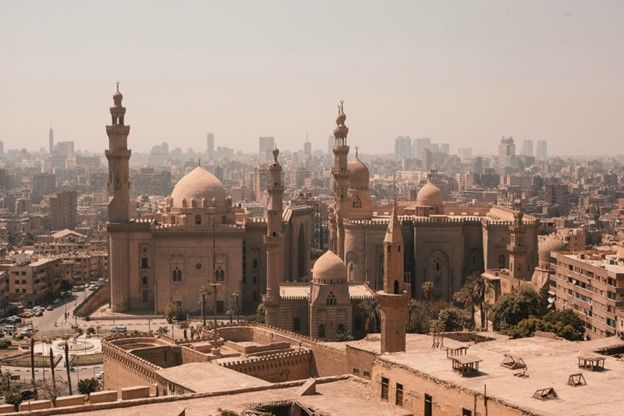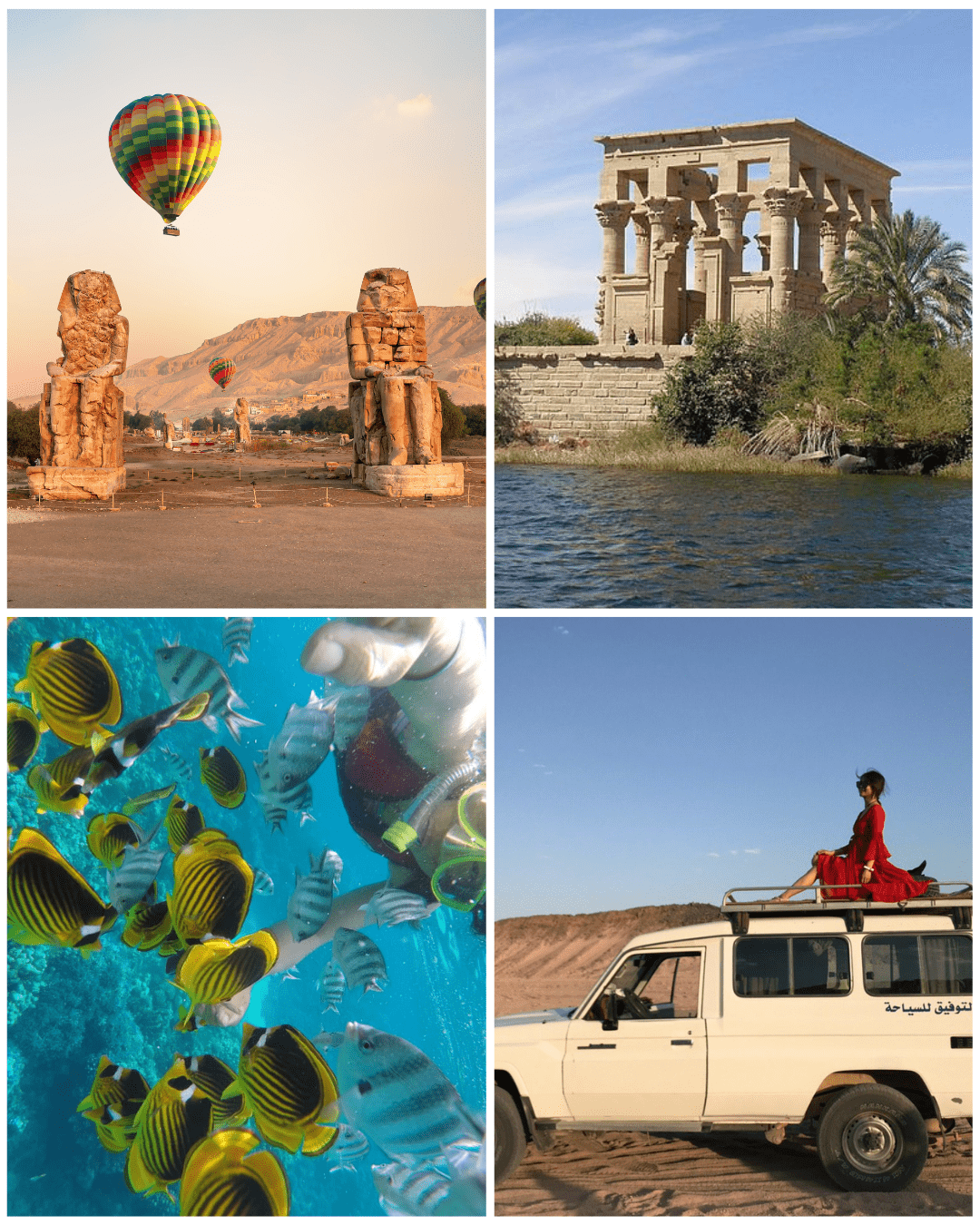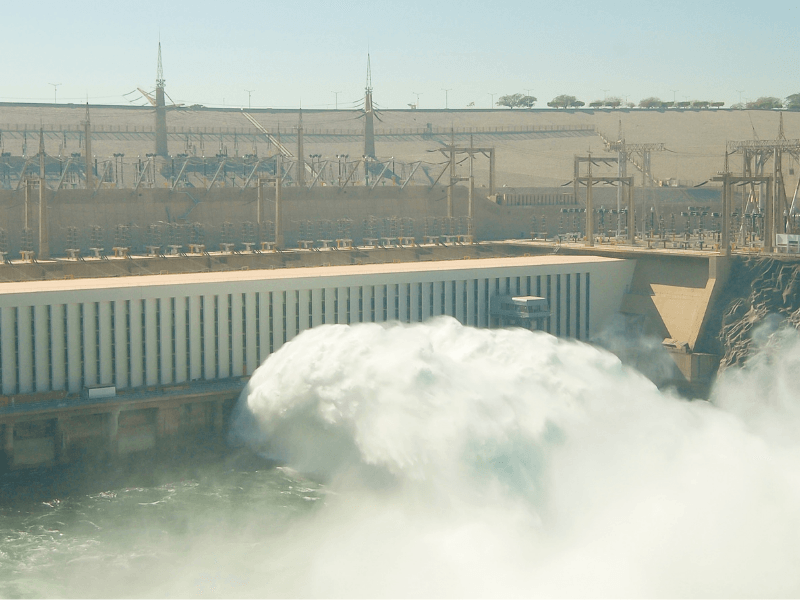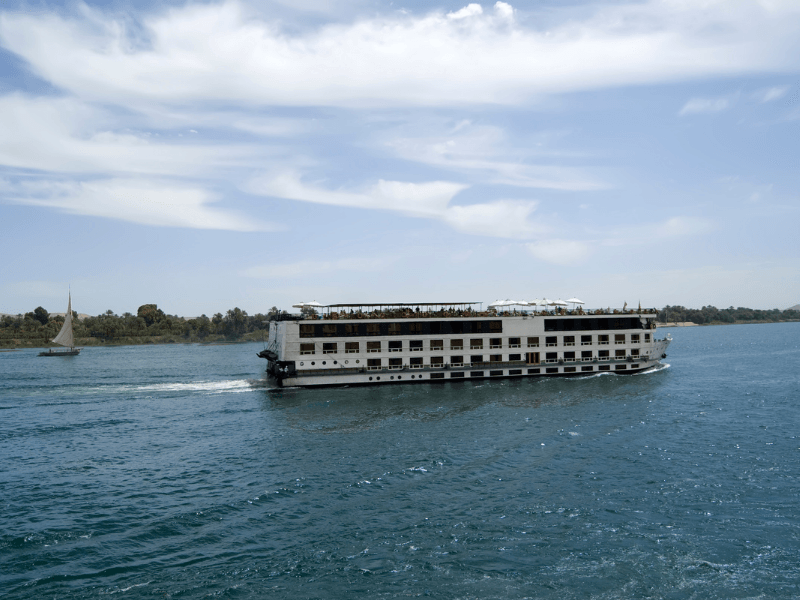Everything You Need to Know About the Nile River
Complete guide about the Nile River
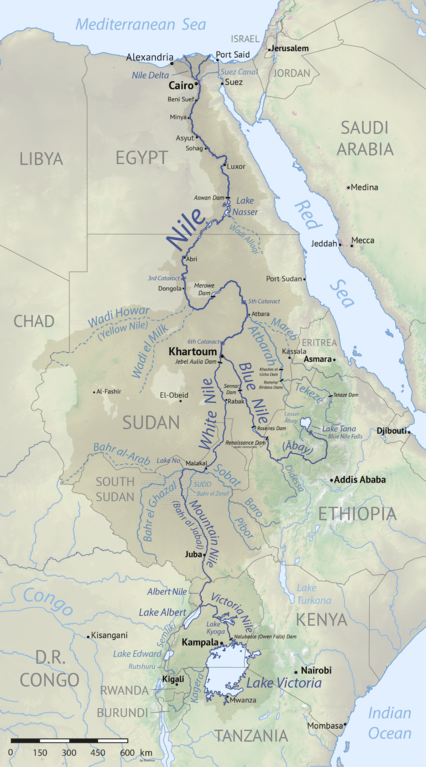
Since the dawn of human civilization, people have depended on and been enthralled by the mighty Nile River. A river steeped in legend, it is as essential to the survival of those that live on its banks today as it was for their ancestors thousands of years ago. In this article, we take a look at its role throughout history and explore how visitors to Egypt can enjoy the river and its many ancient sights.
Geography and Statistics
The Nile River flows northwards through northeast Africa before eventually reaching the Mediterranean Sea via the Nile Delta in Egypt. On its way, it passes through 10 other countries – Tanzania, Uganda, Rwanda, Burundi, the Democratic Republic of the Congo, Kenya, Ethiopia, Eritrea, South Sudan and the Republic of the Sudan. Its route also includes some of the most famous geographical features on the African continent, from Lake Victoria and Lake Albert to Murchison Falls and the Blue Nile Falls.
Three main tributaries contribute to the Nile. These are the White Nile, the Blue Nile, and to a lesser extent, the Atbara River. Determining the source of the main river means finding the source of each of these tributaries. The source of the White Nile is still uncertain, with different theories placing it in either Rwanda or Burundi. Either way, the White Nile is the longest of the Nile tributaries, although it only contributes 20% of the river’s total flow. The Blue Nile starts at Lake Tana in Ethiopia, flowing through Ethiopia and Sudan before joining the White Nile at the confluence just north of Khartoum in Sudan. The Atbara also originates near Lake Tana in Ethiopia.
Although exact measurements vary, the Nile is at least 6,650 kilometers long. This makes it the longest river in Africa and probably the longest river in the world (although some studies contest that the Amazon River is longer). It is certainly not the widest, however, and its relative narrowness means that it carries very little water in comparison with some of the world’s other great rivers. The Congo River, for example, carries 95% more water than the Nile. Nevertheless, the river’s drainage basin covers over 3.3 million square kilometers, equivalent to 10% of the area of the entire African continent.
The Nile in Prehistoric Times
The Nile is incredibly old, having already achieved major river status some 31 million years ago. At some point in its history, it was much longer than it is now. Lake Tanganyika also drained into the Nile so that its furthest headwaters were in northern Zambia; however, this tributary was cut off by the emergence of the Virunga Mountains along the border of Rwanda, Uganda and the Democratic Republic of the Congo.
Today the Nile is synonymous with Egypt, having shaped Egyptian culture for thousands of years. Interestingly, the original course of the river bypassed Egypt, passing through Libya and emptying into the Gulf of Sidra instead. It adopted its current course at the end of the last ice age as a result of rising sea levels, and has been the primary source of water and an essential life support system for civilizations in Egypt and Sudan ever since.
Importance of the Nile in Ancient Egypt
Indeed, Ancient Egypt centered around the Nile River both geographically and metaphorically. The vast majority of ancient cities and monuments were constructed along its banks, so that residents could take advantage of the river for drinking, fishing, bathing, transport and recreation. Perhaps most importantly, the Ancient Egyptians were able to develop advanced irrigation systems that allowed them to harness the Nile’s waters and sustain crops that would otherwise have failed in the arid, desert climate of northeast Africa.
The land of the Nile Valley was made especially fertile by annual floods that deposited nutrient-rich silt on the river banks. This fertility became the basis for one of the greatest and most influential civilizations of all time because it allowed the Egyptians to trade with their neighbors around the Mediterranean and in the Middle East. They grew wheat, flax, beans and cotton for export, and in exchange the country became increasingly rich and powerful. This wealth funded the pharaohs’ ambitious building projects, paving the way for the advances in art and architecture for which Ancient Egypt is so famous today.
Papyrus production also provided paper for the development of the country’s educated classes, while people and goods could be transported throughout the length of Egypt using the river. Even before the advent of engines, sailboats could easily ply the Nile in either direction thanks to prevailing winds blowing southwards, and the current flowing northwards. So crucial was the Nile to the survival of the Egyptian people that their calendar was divided into three seasons, each one defined by a different Nile cycle and the arrival or departure of the annual floodwaters.
The Nile was also vitally important to the Ancient Egyptians on a spiritual level. They knew the river as the Father of Life and Mother of all Men, and believed that it acted as the gateway between life, death and the afterlife. The floods were controlled by the god Hapi, and several other members of the Egyptian pantheon had close connections to the Nile including Khnum, Hathor, Isis and Osiris. Later, the Nile and the fertile lands around it would also support the Romans, who relied heavily on its grain production and status as the bread basket of the Empire.
Recent History of the Nile River
In the millennia since the pharaohs ruled Egypt, the river has continued to sustain each and every civilization that came afterwards. Today, 95% of Egyptians still live within a few kilometers of the Nile, with major urban settlements along its banks including Cairo, Giza, Aswan and Luxor. Modern engineering projects have resulted in some significant changes to the river since ancient times, however. The most notable was the result of the Aswan High Dam, a building project that became one of the primary objectives of the newly established government after the Egyptian Revolution of 1952.
The dam, which was started in 1960 and completed in 1970, is the largest embankment dam in the world. Its purpose was to give Egyptians the power to control the annual floods, which were sometimes so extreme that they wiped crops out completely and sometimes failed to arrive at all. It also generated the hydroelectricity that powered Egypt’s subsequent industrialization, and inundated almost 480 kilometers of the river to create Lake Nasser. Nasser is the second-largest man-made lake in the world with a total surface area of 5,250 square kilometers, making it an invaluable water storage facility for use during periods of drought.
The creation of the lake meant that many ancient Egyptian sites had to be relocated in order to prevent them from being submerged. This was a major undertaking that involved experts from all over the world, with the most famous projects including the relocation of the Abu Simbel temples and the Temple of Isis at Philae.
Controversies Surrounding the Nile
With the completion of the Aswan High Dam and Lake Nasser, Egypt gained a reliable water source for use in agriculture and the generation of electricity. It saved the country from much of the drought and famine that devastated Ethiopia and Sudan in the 1980s; but also sparked controversy from other countries along the course of the Nile who claimed that Egypt had monopolized the life-giving water source. In response, Ethiopia began construction on the Grand Ethiopian Renaissance Dam in 2011.
Once completed, the dam will drastically reduce the supply of water from the Nile into Lake Nasser, benefitting Ethiopia and Sudan but having potentially catastrophic results for Egypt. This includes the loss of around a third of the electricity generated by the Aswan High Dam, and reducing the water available to counteract drought years. For the Ethiopians, the dam will provide electricity to three quarters of the population who are currently without it. With so much at stake, it is no wonder that control of the Nile’s water supply remains a topic of great controversy between Horn of Africa and East African nations.
Also of concern is the environmental effect of damming the Nile and eliminating the annual floods that sustained it for thousands of years. Without the floods, the river cannot purge itself of human and agricultural waste and is consequently becoming increasingly polluted. And while the completion of Ethiopia’s dam will further reduce the flow of the river, rising sea levels as a result of climate change are causing saltwater to intrude into the river’s northern reaches from the Mediterranean Sea. Ultimately, projections show that up to a third of the Nile Delta could be lost to the sea in coming years.
Cruising the Nile River
For now though, the Egyptian Nile continues to be the place of beauty and historical significance that it always has been. For modern Egyptians, tourism is one of the most important Nile-related sources of income. For visitors, the fact that the majority of the country’s most iconic monuments are located along the banks of the Nile makes a cruise an excellent way to see them in style and comfort. Nile cruises typically ply the river in between Luxor and Aswan, stopping at Esna, Edfu and Kom Ombo en route.
Itineraries differ, of course, but potential stops and highlights along the way include the grand temple complexes at Luxor and Karnak, the Theban necropolis including the Valley of the Kings and the Valley of the Queens, the Temple of Horus at Edfu, the Temple of Khnum at Esna and the Temple of Kom Ombo. Some cruises also continue past Aswan to Agilkia Island, the new home of the Temple of Isis after its relocation prior to the flooding of Lake Nasser.
There are many different kinds of Nile cruise to choose from, depending on your budget and preferred way of travelling. Some vessels are old-fashioned paddle steamers that allow you to explore the river in the same grand style that the explorers of the 19th and early 20th centuries might have done. One, the Steam Ship Sudan, was built in 1885 for King Fuad and inspired Agatha Christie’s famous novel, Death on the Nile. Alternatively, those that prefer more contemporary comforts may choose a luxury cruiser with everything from spas to swimming pools and dance floors; while traditional feluccas provide a budget option for those on a shoestring.
Explore the Nile With Pyramids Land Tours
Pyramids Land Tours offers a range of curated Nile cruise experiences, all of which benefit from our insider knowledge and impeccable customer service. Perhaps you’re headed to Cairo and have only a few hours to spare? Our dinner cruises take you out on the river for two to three hours, during which time you’ll be treated to an authentic Egyptian feast while being entertained by belly dancing and whirling dervish performances. If you have more time on your hands, choose from a selection of multi-day tours that ply the route between Luxor and Aswan.
These overnight experiences last between four and seven days, depending on the itinerary you choose. All options include full board accommodation on a luxury cruise ship, entrance fees for all of the ancient sights and attractions mentioned in the itinerary, and the services of a professional Egyptologist guide. This all-inclusive style means that from the moment you step aboard, you’ll have nothing to worry about other than enjoying your time on the world’s most fascinating river to the full.
We also offer multi-day Lake Nasser cruises for those that want to discover the world-famous temples of Abu Simbel as well as some of Egypt’s lesser known and less crowded ancient sights. These include the Temple of Kalabasha, the New Kingdom temples of Wadi El Seboua, and the Temple of Amada. The latter is of particular interest, being the oldest surviving monument in all of Nubia, with well-preserved reliefs that are renowned for their exceptional quality.
Enjoy the Nile with our Egypt Nile Cruises



